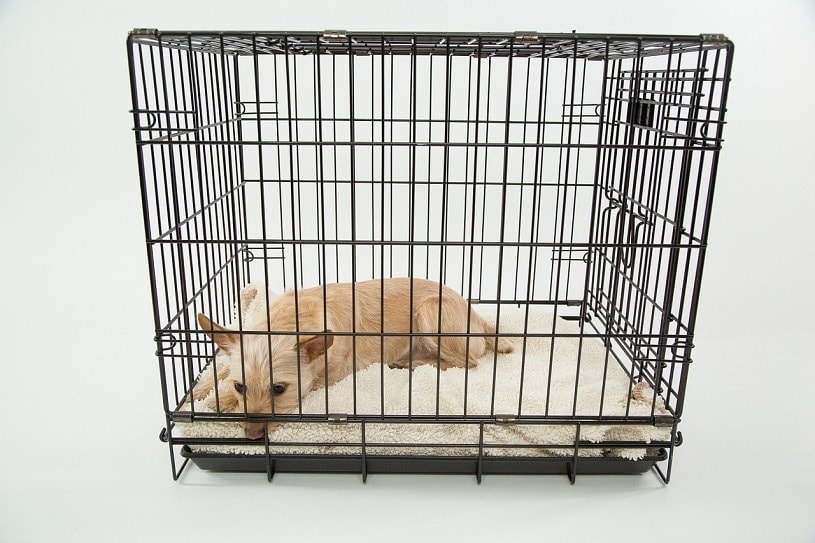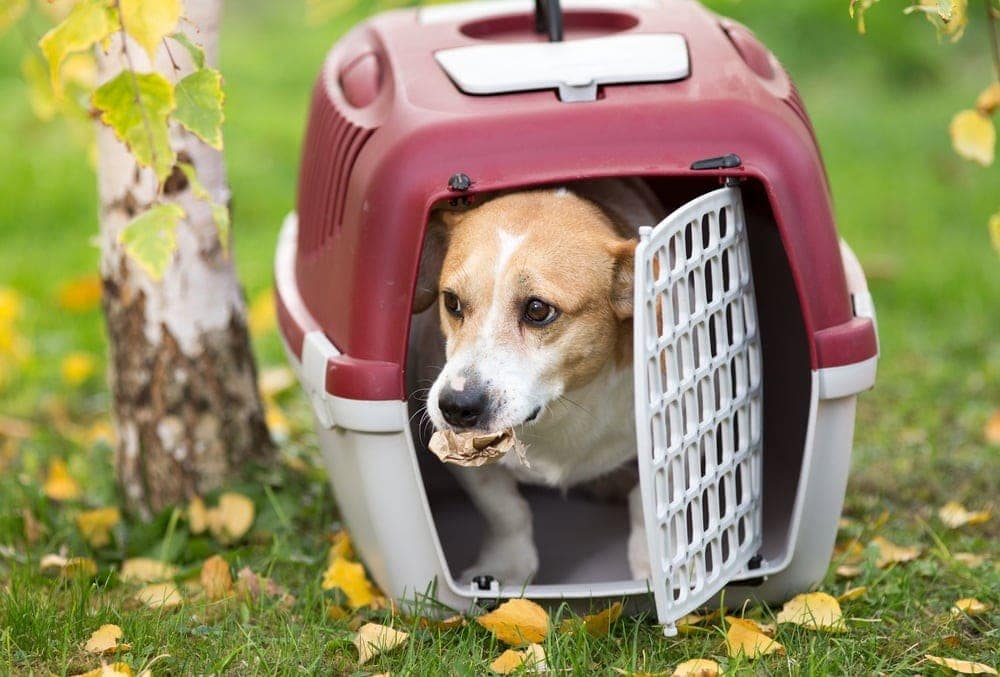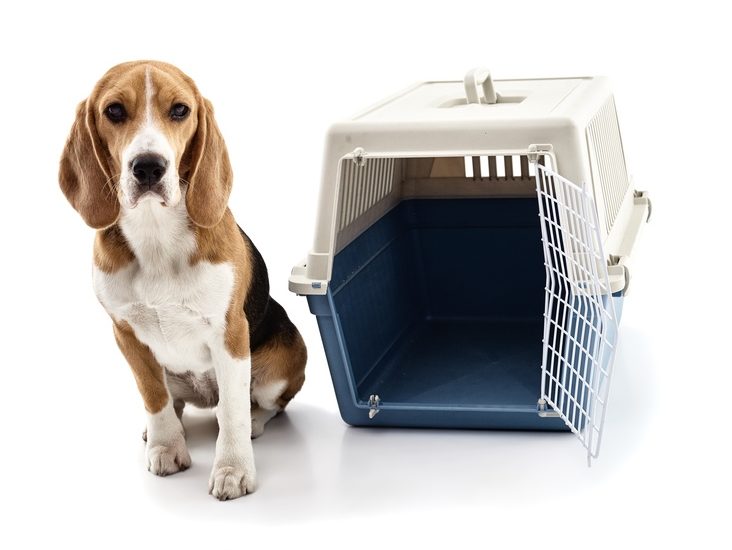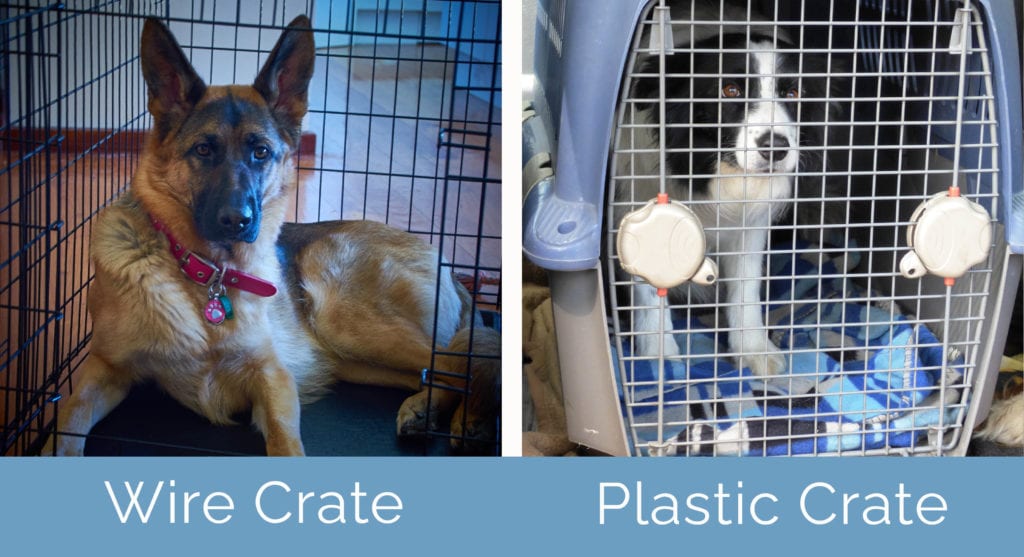Plastic vs Wire Dog Crates: The Differences (With Pictures)

Updated on

If it’s time to get your four-legged friend a new crate, you may be torn between a plastic or a wire dog crate. In this guide, we will go through all the differences and the benefits and disadvantages of both types of crates.
When you are finished reading, you should have a much better idea of what you need and why!
Visual Differences
Wire Dog Crate Overview

A wire dog crate can come in a variety of sizes, and it has very large areas for a dog to see through. The wire crate is a more open way to contain your dog in that it allows them to see the world around them. Wire crates generally have a plastic bottom that you can take out and clean. The wire edges of the crate are thick wire, and they are painted with a smooth finish. You should always inspect a wire crate to make sure it is built well, but you should not have trouble with the wire hurting your dog in any way.
Sizes
Wire dog crates range in size. The most common models range from 24 inches up to about 54 inches. Depending on the size of your dog, you will need to change the size of your crate. If you purchase a large breed puppy, you will want to choose the larger crate to make sure they have room to grow into it.
Styles
Most wire crates are relatively standard rectangular shapes with a plastic-type tray at the bottom. The crate usually has one door at the front that will have one or multiple latches to keep your dog secure. There are a few wire crates on the market that offer a fleece pad on the bottom. Most are left empty for the owner to place toys, bedding, etc. inside the crate.
Portability
Wire crates are heavy simply because they are made of wire. Some models are available on wheels, but they will cost quite a bit more. The one great thing about wire crates is that they usually are foldable and can be stored away quickly and easily.

Pricing
Depending on the quality and the features of the crate, you can spend anywhere from $20 up to $500. The majority of wire crates are going to fall in the $100–$150 price range.
- Excellent visibility for the dog
- Easy to clean
- Easily stored away
- Secure and durable
- A dog may not feel as comfortable or secure
- The dog may bark and beg to get out since it can see everything going on
- Heavy
Plastic Dog Crate Overview

A plastic dog crate helps to create an excellent den-like environment for your dog. The visibility for the dog in a plastic crate is much less than it is in a wire crate, but that may be a good thing. Plastic crates are easy to move around and work for both small and large dogs. A plastic crate usually has one door at the front that will have one or more latches on it.
Sizes
Plastic crates are available in the very same sizes as wire crates. Since the plastic crates can feel a little more enclosed than a wire crate, make sure you are getting a size that properly accommodates your dog.
Styles
Most plastic crates have the same style. They provide limited visibility but a comforting den-like environment for your dog. If your dog struggles with anxiety or you are traveling to a new area and don’t want to upset your dog, the plastic crate can work very well. Plastic crates are not usually foldable like the wire crates; however, they can generally be taken apart when you are finished with them.
Portability
Plastic dog crates are much lighter than wire dog crates. You will have no issues moving your plastic crate to another location in your home. If your dog is smaller, you can use the plastic crate as a carrier for trips to the vet or the park. The plastic crate will not add very much weight when carrying a small dog around.
https://www.instagram.com/p/CITx4YMJx7c/?utm_source=ig_web_copy_link
Pricing
Plastic crates can cost anywhere from $25 to hundreds of dollars. Most of the time, the price of the plastic dog crate will vary based on the size you are purchasing.
- Suitable for dogs who get anxious when looking out
- Creates a den-like home for a dog
- Good for travel
- Lightweight
- Easy to move around
- Easy to rinse out and clean
- Less airflow
- Can feel confining
- Can hold odor over time
Which One Should I Get?
As you can see from the information provided, there are both positives and negatives to wire and plastic dog crates. Choosing which one is right for your animal comes down to a few key questions. Here are the things you should consider before choosing which crate works for you and your family.
Dog Personality
Is your dog going to sit in their crate, stare at you, and bark? Is your dog an animal that likes to see everything that’s going on and not miss a minute of the action? You need to consider your dog’s personality and how it will affect the crate that you need to purchase. One trick that many dog owners will use is a blanket over a wire cage.
If you think the plastic is too confining for your dog but the wire is too open, you can place a lightweight blanket over the top of the wire crate. The blanket will help the wire cage feel more enclosed when it is necessary, but you can easily remove it without having to buy an entirely new crate.

Dog Size
Generally speaking, more substantial dogs do better in wire crates. Wire crates feel bigger than plastic crates. Although small dogs can use a wire crate and large dogs can use plastic, if you have a large-breed puppy, you will want to look into the wire crate options.
Another thing to consider is that in colder climates, a plastic crate will work to help keep your small dog a little warmer. The same can be said in warm climates, where leaving a large dog in a plastic crate could cause them to feel a bit overheated. Of course, this will depend on the location of the crate, but it is something that should be considered.
Cleaning
Both wire and plastic dog crates can be cleaned relatively easily. The only problem that you may run into is that plastic crates tend to hold odor after a while. If your dog is prone to accidents, you may want to consider a wire crate. If you need to replace the plastic bottom tray in a wire crate, it’s much better than having to replace an entire crate.

Portability
If the reason you are buying a crate is so that your dog has a space in your home that will be considered their bedroom, then a wire crate is just fine. However, if you need something that works more as a carrier or works for traveling, the plastic crate is a better option. Plastic containers are lighter and easier to move around. The wire crate is very easy to fold up, but that doesn’t help all that much if you are traveling and need to fold and unfold the crate continually.
Conclusion
There is no real winner when it comes to a plastic crate vs. a wire crate. Many dog owners find themselves having several crates for their pets. Make sure you carefully consider your dog’s size and the intended location of the crate before you purchase one. Also, if your dog seems to be a bit of a Houdini, make sure you get a crate with latches that are secure and difficult to break out of. Regardless of which crate you buy, make sure your dog loves it and feels as though they are comfortable and at home inside.
See also:













